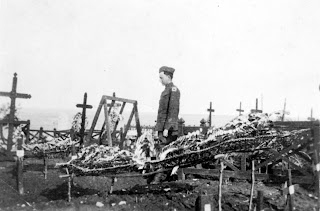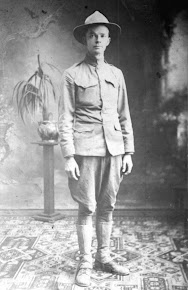In honor of upcoming Memorial Day, I found a local history story that is an ocean away, in some of the most beautiful natural surroundings European countries have to offer, surrounded with flags of the United States. They are the American Cemeteries maintained by the American Battle Monuments Commission (ABMC), a government agency founded in 1923 that now manages 26 cemeteries and 35 monuments created after a variety of wars across four continents. The land is generously donated in gratitude to America, and is never taxed in these foreign countries. Forty percent of these cemeteries and monuments are in France.
One of these cemeteries in France, Aisne-Marnes (Aisnes is pronounced Enne) near Belleau, France, northeast of Paris, is the final resting place of PFC. Henry Homer Dalrymple, who was born on July 21, 1892 in Bossier Parish. Homer, as he was known, was raised in the rural Midway/Linton community near Benton and died July 1, 1918, just shy of his 26th birthday in the Picardie region of France (now known as the Hauts-de-France). He was killed in action by a direct hit with a high explosive, where the French and the American Expeditionary forces were holding off the Germans at the Marne River, just ahead of the famous battle of Château Thierry.
Homer Dalrymple’s first burial on his Army burial record listed an American cemetery at the Bézu-le-Guéry, near the village of Château Thierry. There was an American field hospital located there. Its purpose so close to the front was primarily triage. Burial at a field hospital would have likely meant burial in a mass grave, or at least a temporary or hastily constructed one. Homer Dalrymple’s burial record shows that he was reinterred in the beautiful American Cemetery in Belleau France, now known as the Aisnes-Marne, on June 10, 1919.
Another photo in our collection, this one of a Bossier WWI soldier who made it home and lived to an old age, was of Dan Rials (Arthur Daniel Rials), who was a member of Company B, 13th Engineer Corps of the US Army. This touching photo, though of a different location in France, may help to explain Homer Dalrymple’s reburial. The photo shows a young Dan Rials in uniform walking among tall wooden crosses and flower-covered yet spindly-looking makeshift funeral biers, platforms for coffins before they are lowered into the ground, identified on the photo as Fleury-sur-Aisne, France, circa 1919.
Fleury-sur-Aisne was a Red Cross “evacuation” hospital used following German advances into France. An online search for Fleury-sur-Aisne yields an even more somber photograph, a chaplain at a burial service there, praying over shrouded bodies in a mass grave of soldiers who had died at the hospital. It’s difficult to look at, but yields much information about death at the frontlines. It is likely, though, that those soldiers too would later have gotten their own cross, or Star of David if they were Jewish, at a permanent American cemetery, such as the beautiful Aisne -Marne mentioned above or the Meuse Argonne, also managed by the American Battle Monuments Commission, or sent back to the United States if their family so chose.
In fact, the American Battle Monuments Commission got its start at the end of WWI. The United States was granted plots of land by the Allies to bury their fallen. Six cemeteries were created in France, one in Belgium, and one in England, as perpetual, tax-exempt property of the U.S. government. Responsibility for their care and maintenance was placed in the hands of the ABMC in 1923.
Homer Dalrymple’s mother Lydia Dalrymple, did not request that her son’s body be returned home, but she did take advantage of the opportunity to go to France as a “Gold Star Mother” (a mother who lost one or more children in the war) to visit the grave of her son in the stunning, new American Cemetery at Aisne-Marne. The History Center has a photo of her, labeled as “Grandma Dalrymple”, by then looking quite elderly, beginning her trip on board a train in Dallas. This was possible because in the late 1920’s, the War Department of the United States compiled a list of mothers and widows of WWI soldiers killed and buried in Europe and offered to take them to their loved ones’ graves. Between 1930 and 1933, 6,000-plus women traveled on these “Gold Star Mother Pilgrimages”. The trips were entirely planned and paid for by the U.S. Army, a relatively rare act of public support for the private grief of families of the fallen.
If you would like to see these or other photos, such as those in our current Red Cross exhibit, visit us at the History Center, or ask us how to use our online catalog, which includes digitized images. We are located at 2206 Beckett St, Bossier City, LA and are open M-Th 9-8, Fri 9-6, and Sat 9-5. Our phone number is (318) 746-7717 and our email is history-center@bossierlibrary.org
For other fun facts, photos, and videos, be sure to follow us @BPLHistoryCenter on FB, @bplhistorycenter on TikTok,
Images:
- Dan Rials, 1919, in Fleury sur Aisne, France
- Postcard photo of Homer Dalrymple 1892-1918 in World War I uniform. He was in the 48th Infantry Co. H. He was killed near Château Thierry and buried in France.
- Burial register card for Henry Homer Dalrymple. US National Archives: Record Group 92, Office of the Quartermaster General, Card Register of Burials of Deceased American Soldiers 1917 – 1922



No comments:
Post a Comment